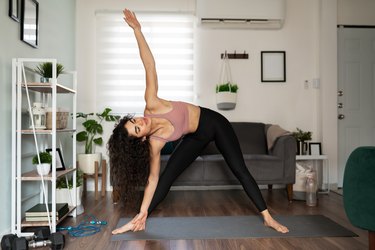If the many types of yoga are like an onion, then Hatha yoga would be the first layer. This stress-relieving and meditation-inducing practise focuses on many of the foundational yoga poses and is suitable for both newcomers and seasoned practitioners.
Learn what to expect from your first Hatha yoga session, and how to maximise its advantages, right here.
What Is Hatha Yoga?
Hatha yoga encompasses all of yoga’s physical modalities. The Sanskrit term “hatha” means “sun-moon,” or the joining of two seemingly opposing concepts. This style of yoga includes a number of postures, or asanas, that work to increase strength and range of motion. Hatha yoga is the foundation for other styles of yoga like Ashtanga and Vinyasa.

Oxon Hill, Maryland-based yoga instructor Candy Glover tells LIVESTRONG.com that her students are able to achieve mental and physical harmony via their practise. This is accomplished by stressing the following eight principles:
Yama, or self-control,
Niyama (restraint)
Posture (or asana)
Breath regulation (Pranayama)
Withdrawing one’s senses from their objects, or pratyahara.
Dharana, or focused attention
(Meditation) Dhyana
Meditation in Samadhi
Brandie Regaldo, a yoga instructor and co-founder of SAY OM SA in San Antonio, says, “Balance is so hard to come by in our fast-paced culture.” “From my own experience as a practitioner and as a teacher, I have seen that a Hatha class is often the first opportunity some people have to actually slow down, tune into their body and mind, and revitalise themselves all at once.”
5 Benefits of Hatha Yoga

Each yoga asana is a complete workout in and of itself. A study published in June 2015 in Evidence-Based Complementary Medicine found that after 12 weeks of Hatha yoga, a group of 154 middle-aged Chinese people had increased muscle strength and endurance.
2. More Flexibility and Mobility

Working out involves stretching and using the full range of motion of your muscles. According to the American Osteopathic Association, this can improve range of motion in the joints and muscles.
People with stiff joints and athletes who want to improve their performance can benefit greatly from this.
3. Better Posture and Alignment
 Your posture will improve with time as well. The American Osteopathic Association reports that fixing your posture does more than just reduce back discomfort; it also benefits your lungs.
Your posture will improve with time as well. The American Osteopathic Association reports that fixing your posture does more than just reduce back discomfort; it also benefits your lungs.
Glover claims, “Through my practise of Hatha yoga, I’ve developed better air flow and breathing practises.”
4. Better Stress Management

You’ll quickly realise how important breathing is in Hatha yoga, both for getting into and out of poses and for expanding your comfort zone and trying something new. It’s simple to apply these principles to your life away from the mat. Concentrating on your breathing can assist calm your mind and body when you’re under pressure.
5. A Healthy Body Weight
Regaldo says she was able to shed pounds by sticking to her schedule. She lost 85 pounds over the course of four years and has kept it off for the past 12 years thanks to her regular practise of Hatha yoga. “There are so many benefits to practising Hatha yoga regularly,” she says.
30 minutes of Hatha yoga can help you burn between 120 and 178 calories, depending on your weight, says Harvard Health Publishing. Check out the estimated calorie expenditure:
What to Expect at Your First Hatha Yoga Class
The pace of a Hatha yoga class is entirely up to the teacher; what matters most is that you go at your own pace and focus on breathing through the transitions between postures.
Asanas typical in a Hatha yoga practise include the Downward Facing Dog, Cat/Cow, Child’s, and Mountain positions. Not only do these poses help even the most experienced yogis simplify their practise when they need to, but they are also wonderful for novices to learn.
The teacher will tell you how long you should hold each pose, but usually it’s between five and ten breaths. Don’t be afraid to ask for a modification if you’re unable to do a particular stance.
Regaldo also recommends relaxing into the practise and not worrying about achieving any particular goals, such as making it through the full hour of class time or mastering every position.
Also Read: Developing Self-Awareness – Understanding Yourself
I encourage you to replace judgements and rules with self-exploration and inquiry during your time on the mat. The effects of even just five minutes of deliberate movement and breathing are profound.




